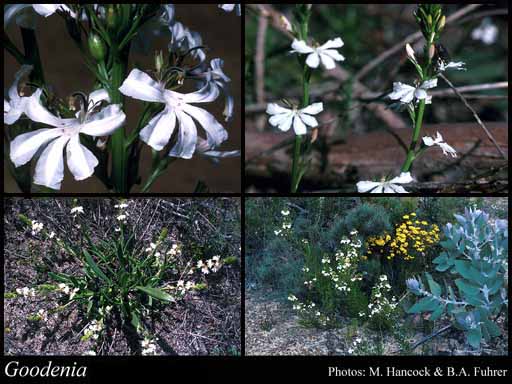- Reference
- Spec.Bot.New Holland 15 (1793)
- Name Status
- Current







Scientific Description
Common name. Goodenias. Family Goodeniaceae.
Habit and leaf form. Shrubs, or herbs. Annual, or perennial. Leaves basal, or cauline, or basal and cauline. Plants with a basal concentration of leaves, or with neither basal nor terminal concentrations of leaves. Stem internodes solid (ass.). Mesophytic, or xerophytic. Leaves alternate; spiral; petiolate to sessile; non-sheathing; simple; epulvinate. Leaf blades dissected (occasionally), or entire; flat, or folded, or solid; sometimes terete, or semi-terete; linear, or ovate, or obovate, or oblong, or elliptic; when dissected, pinnatifid; pinnately veined. Leaves without stipules. Leaf blade margins entire, or serrate, or dentate. Leaves without a persistent basal meristem. Leaf anatomy. Hairs present, or absent; glandular hairs absent, or present; complex hairs present, or absent. Extra-floral nectaries absent (ass.). Stem anatomy. Secondary thickening absent, or developing from a conventional cambial ring.
Reproductive type, pollination. Fertile flowers hermaphrodite. Unisexual flowers absent. Plants hermaphrodite. Entomophilous. Pollination mechanism conspicuously specialized (involving a stylar modification for pollen presentation).
Inflorescence and flower features. Flowers solitary, or aggregated in ‘inflorescences’; terminal, or axillary; in cymes (in a thyrse), or in racemes, or in spikes, or in umbels (or subumbel), or in panicles, or in fascicles (or clusters). The terminal inflorescence unit cymose, or racemose. Inflorescences scapiflorous, or not scapiflorous; terminal, or axillary; with involucral bracts (rarely), or without involucral bracts. Flowers pedicellate (usually), or subsessile to sessile; ebracteate (ass.); bracteolate, or ebracteolate; small to medium-sized; very irregular. The floral asymmetry involving the perianth and involving the androecium. Flowers 5 merous; cyclic; tetracyclic. Free hypanthium absent. Perianth with distinct calyx and corolla; (8–)10; 2 -whorled; isomerous, or anisomerous. Calyx present; 5; 1 -whorled; gamosepalous; tubular. Corolla present; 5; 1 -whorled; appendiculate (the upper lobes sometimes auriculate), or not appendiculate; gamopetalous; lobed. Corolla tube adaxially deeply split. Corolla valvate; bilabiate; hairy abaxially, or glabrous abaxially; hairy adaxially; white, or cream, or yellow, or red (brownish), or pink, or purple, or blue; spurred, or not spurred. Androecial members definite in number. Androecium 5. Androecial members free of the perianth, or adnate; all equal (ass.); free of one another; 1 -whorled. Androecium exclusively of fertile stamens. Stamens 5. Staminal insertion near the base of the corolla tube. Stamens all inserted at the same level; all more or less similar in shape (ass.); isomerous with the perianth; oppositisepalous (at the base of the corolla); all alternating with the corolla members. Anthers separate from one another; basifixed; dehiscing via longitudinal slits; introrse; tetrasporangiate. Pollen shed in aggregates, or shed as single grains. Gynoecium 2 carpelled. The pistil 1–2 celled. Gynoecium syncarpous; synstylovarious to eu-syncarpous; partly inferior (summit of ovary extends upwards within the corolla tube), or inferior (AKPB). Ovary plurilocular; 2 locular (usually incompletely). Gynoecium stylate. Styles 1; bearing an ‘indusium’ beneath the stigma. Indusium cupular. Styles apical. Stigmas 1–4. Placentation axile. Ovules 20–50 per locule (numerous to few, rarely solitary per locule); ascending; non-arillate; anatropous.
Fruit and seed features. Fruit non-fleshy; dehiscent; a capsule. Capsules valvular. Fruit 2 celled (usually, or 4); 1 seeded (to more than 2 per locule). Seeds copiously endospermic. Endosperm oily. Seeds compressed; usually winged. Cotyledons 2. Embryo straight.
Special features. The upper lip of the corolla incorporating 2 members, the lower 3; (posterior, adaxial) lip of the corolla bilobed. Lower (abaxial) lip of the corolla 3 lobed.
Etymology. After Samuel Goodenough (1743–1827), Bishop of Carlisle, first treasurer of the Linnean Society. He deplored ‘the gross prurience of Linnaeus' mind’ as shown in his sexual system of plant classification.
Taxonomic Literature
- Sage, Leigh W.; Shepherd, Kelly A. 2007. Five new conservation-listed species of Goodenia (Goodeniaceae) from southern Western Australia.
- Sage, L. W.; Dixon, K. W. 2005. Goodenia pedicellata (Goodeniaceae), a new species from the Pilbara bioregion of Western Australia.
- Wheeler, Judy; Marchant, Neville; Lewington, Margaret; Graham, Lorraine 2002. Flora of the south west, Bunbury, Augusta, Denmark. Volume 2, dicotyledons. Australian Biological Resources Study.. Canberra..
- Sage, L. W. 2001. New taxa in Goodenia (Goodeniaceae) from the Kimberley region of Western Australia.
- Sage, L. W. 2000. New taxa in Goodenia (Goodeniaceae) from the south-west of Western Australia, with an update to the Goodenia key in the Flora of Australia.
- Sage, L. W. 1998. New subspecies of Goodenia drummondii and G. laevis (Goodeniaceae) from the south-west of Western Australia.
- Sage, L. W.; Pigott, J. P. 1998. Status and identification of Goodenia filiformis (Goodeniaceae).
- Cranfield, R. J.; Sage, L. W. 1997. Goodenia katabudjar (Goodeniaceae), a new species from south-west Western Australia.
- Australian Biological Resources Study 1992. Flora of Australia. Volume 35, Brunoniaceae, Goodeniaceae. Australian Govt. Pub. Service.. Canberra..
- Carolin, Roger 1990. Nomenclatural notes and new taxa in the genus Goodenia (Goodeniaceae).
- Carolin, R. C. 1980. New species and new combinations in Goodeniaceae and Campanulaceae.